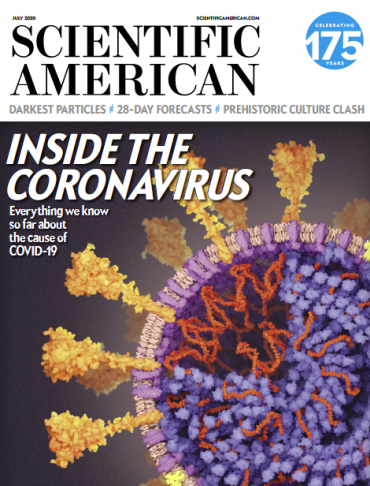The July 2020 issue of Scientific American magazine has a cover story “Inside The Coronavirus.” The image on the cover shows the coronavirus with spikes sticking out from a circular cross-section that appears to have DNA-like structures in it. It’s a colorful and compelling image. There is only one problem: it’s not an electron micrograph (a photo). It’s an illustration, also known as a drawing. Drawings can be creative and beautiful, but, they are not very scientific.

Doesn’t that seem strange to you? The whole world has been changed because of the coronavirus and there isn’t a single photo of it to go with a cover story on Scientific American? It’s especially strange considering the use of the word “Inside” in the article’s title. It seems to imply that they will help you to see inside the virus. They don’t!
There are no photos in the body of the article either, only a few simplistic diagrams. Here is an interesting sentence from the article: “We explain some of the virus’s surprising abilities, such as its capacity to proofread new virus copies as they are being made to prevent mutations that could destroy them.”
Apparently, instead of mutating like any other virus, this genius of a virus realizes that it is already so lethal to humans that it has no need to mutate and, so, it prevents any mutations that could make it less of a danger to people. They should have called it the Einstein virus.
Half of the article is about drug and vaccine intervention. It’s hard not to wonder: Is it a science article? Or is it marketing? Unfortunately, science and marketing have been blurred together as Aldous Huxley foresaw:
“A democracy depends on the individuals making an intelligent and rational choice in what he regards as enlightened self-interest in any given circumstance. But… the purposes of selling goods and the dictatorial propaganda is to try to bypass the rational side of man and to appeal directly to the unconscious forces below the surface so that you are in a way making nonsense of the whole democratic procedure which is based on a conscious choice on rational grounds.”
Others have noticed the decline of Scientific American. In the article ‘The “Unscientific” Scientific American’ the authors discuss another article from Scientific American:
“The article, “The US Needs to Tighten Vaccination Mandates,” states, “[T]here isn’t an iota of doubt that vaccines are a safe and effective way to prevent many diseases.” No scientific evidence whatsoever to raise doubt? Despite a Supreme Court ruling that vaccines are “unavoidably unsafe?” Perhaps more disconcerting is that the essay was written by the magazine’s “Editors,” meaning this is now Scientific American’s official policy statement regarding vaccination rather than being the opinion of a single author. In effect, the magazine is telling its readers that it stands firmly behind the CDC propaganda machine and we should never expect to see any scientific evidence that challenges the magazine’s vaccine dogma within its pages.”
I think we have now rounded a corner. Now, when we hear that “a study shows,” “recent research indicates,” “the scientific consensus is,” or similar such pronouncements, our initial reaction should be “okay what kind of BS do they want us to believe now?”
The author of Not Even Trying: The Corruption of Real Science appears to agree. From the Amazon blurb for the book:
“Researchers are no longer trying to seek and speak the truth. Scientists no longer believe in the truth. They no longer believe that there is an eternal unchanging reality beyond our human organisation which they have a duty to discover and disseminate. Hence, the vast structures of personnel and resources that constitute modern science are not real science but merely a professional research bureaucracy.
“The consequences? Research literature must be assumed to be worthless or misleading and should almost always be ignored.”
Further Reading:
The “Unscientific” Scientific American